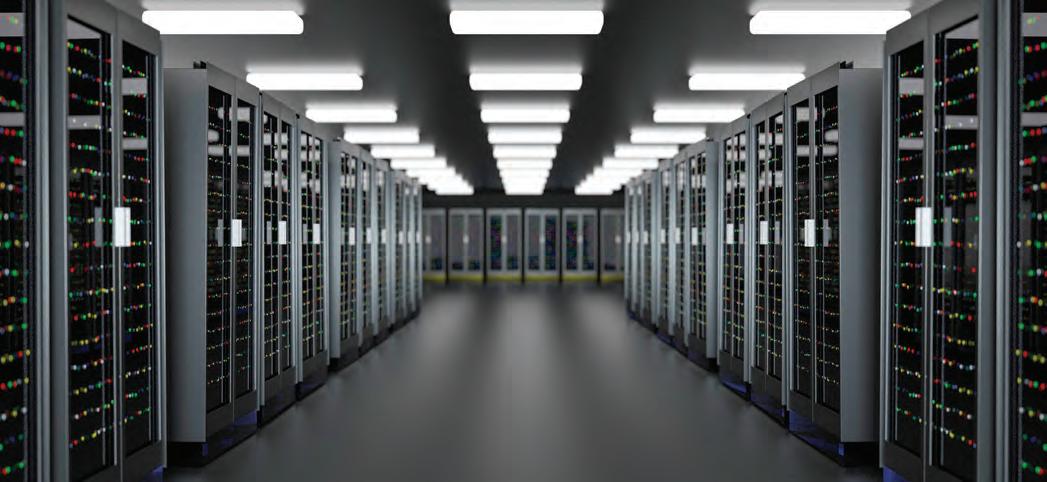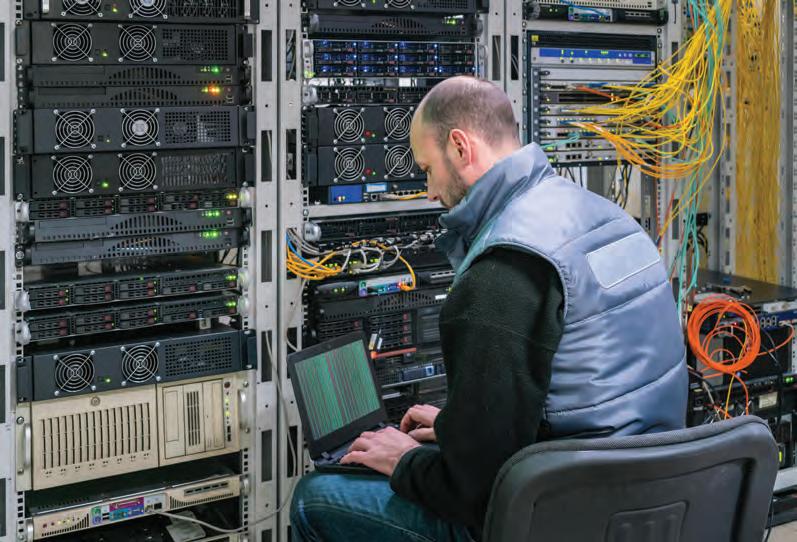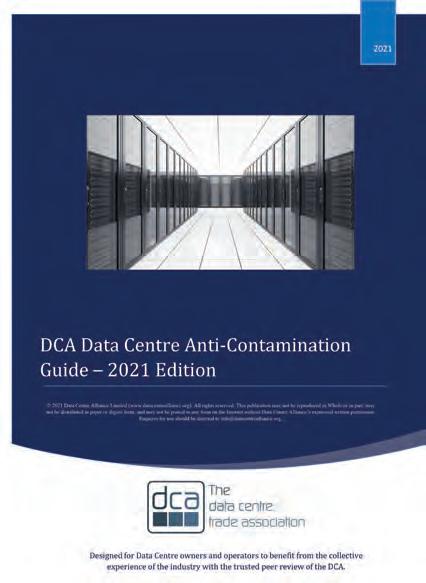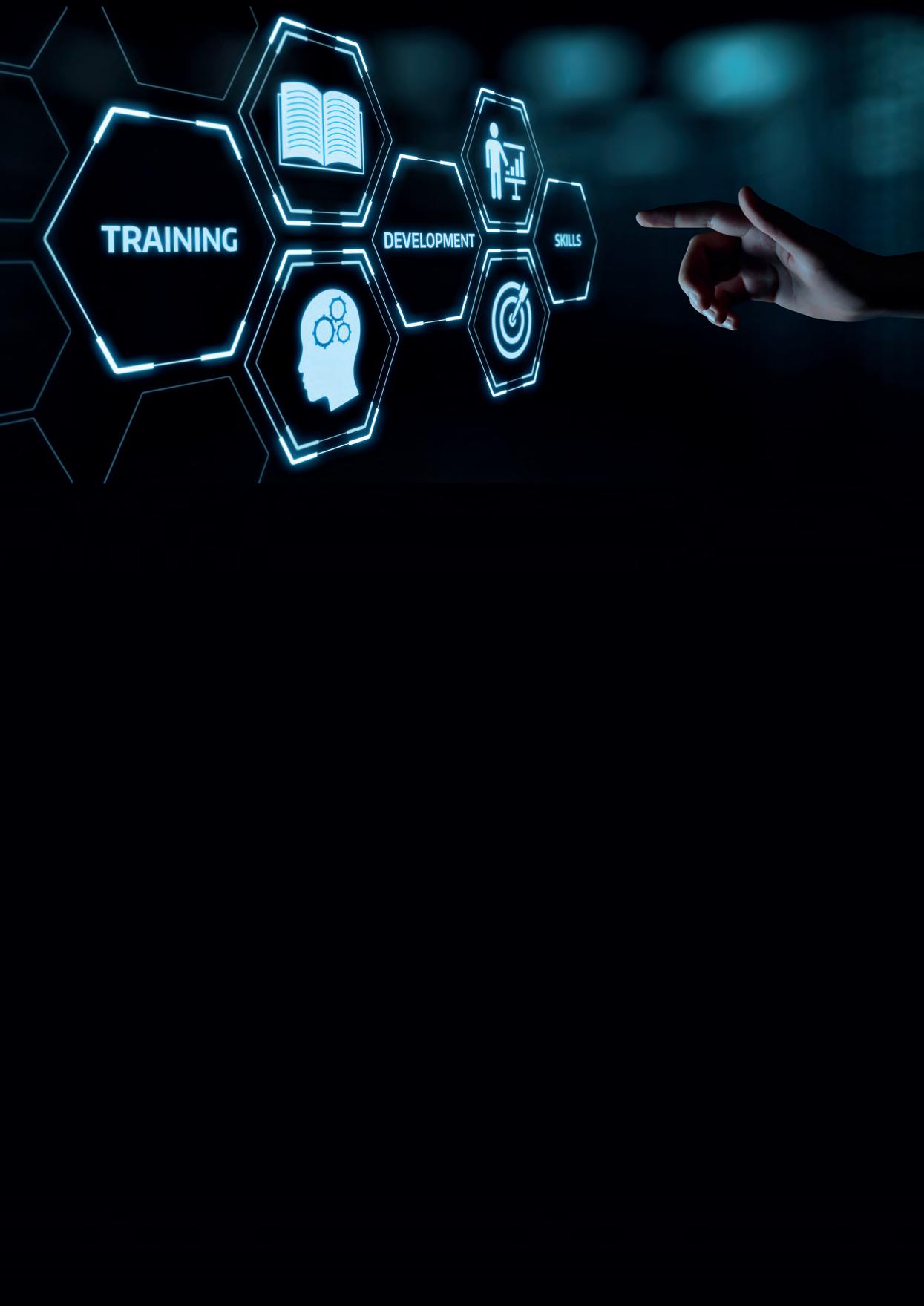
19 minute read
Canal Extremadura’s IT infrastructure revamp with Quantum
STORAGE
Canal Extremadura’s IT infrastructure revamp with Quantum
Advertisement
Setting its sights beyond traditional radio and TV services, Canal Extremadura is in the midst of a large-scale digital transformation. Headquartered in Mérida, Spain, the company aims to become a public multimedia corporation that produces rich, captivating content for a wide variety of platforms. BY QUANTUM
TO ACHIEVE its digital transformation, the Spanish television network needed to dramatically improve its IT infrastructure, as it lacked the flexibility to support the evolving business and scale with its fast-growing volumes of multimedia content.
The company’s existing archive was a major obstacle as it had reached capacity and expanding it was not financially feasible. As Francisco Reyes, technical chief at Canal Extremadura, explains, “We ran out of room in the tape library and had to migrate some video to a NAS just to free up space.” Canal Extremadura’s new archive solution needed to integrate well with its preferred media asset management (MAM) system from Dalet, which is an essential part of the company’s media production and post workflow. The new archive also needed to provide a seamless transition from the existing environment, which contained a vast volume of old files in legacy media formats.
The pursuit for a scalable archive
Choosing a new solution was not a decision Canal Extremadura took lightly. As Reyes explains, “We tend to keep solutions for a very long time—we had been
STORAGE
using the DIVA system for about 12 years—so we needed to be very confident in a new solution before making the selection.”
The integration of its Dalet Galaxy MAM system was a key factor in the final decision. Following Dalet’s recommendation, Canal Extremadura opted for a Quantum StorNext solution, which includes Xcellis storage servers, an Xcellis metadata array, a QXS disk storage array, and a StorNext AEL6000 tape library. The tape library, which has 400 slots, uses LTO-8 drives—a significant upgrade from the LTO-3 drives that Canal Extremadura was using before.
“The advice and technical information we received from the Dalet and Quantum teams was very helpful. They gave a very clear picture of how the solution would work and how it would be implemented,” says Reyes.
Quantum StorNext’s networking flexibility has been a great advantage for the company’s IT team in supporting a range of client systems. Most notably, the storage environment is configured to offer Fibre Channel connectivity to 10 SAN clients and 10-GbE connections to multiple NAS clients. Meanwhile, the metadata network uses a 1 GbE connection. To ensure a smooth transition to the new archive solution, the Quantum team provided onsite training for Canal Extremadura. Dalet’s implementation team also supported the existing archive’s migration to the Quantum environment. “The process took some time because we had a lot of data to migrate, but it was quite smooth,” says Reyes.
Retrieving archived content fast
Thanks to the StorNext environment, some content can remain readily available on disk, meaning Canal Extremadura’s journalists, producers, and other team members can now retrieve archived content much faster. “We have more than 100 TB of online storage from Quantum,” says Reyes. “So if someone has completed a project six months ago, it will probably still be online.”
Even when content has been archived to tape, the IT group can quickly deliver it to users. Upgrading from LTO-3 to LTO-8 has enabled Canal Extremadura to store significantly more data on each tape. Now each retrieval request can be completed without having to load multiple tapes, helping journalists be more efficient in their work and meet their deadlines if they’re in a hurry to assemble a new video for a daily news broadcast.
“In the past, users knew they had to wait for content to be retrieved from the archive,” says Reyes. “Now it’s much faster than before. We have more drives and faster drives with the Quantum archive.”
Collaborating with a single vendor has also eliminated some of the compatibility issues experienced with the company’s previous multi-vendor environment. Having a single point of contact also simplifies getting ongoing support from Quantum.
Stepping into a multimedia transformation
With a new long-term scalable archive environment in place, Canal Extremadura is now better prepared for its multimedia future. “If we ever need to expand the archive in the future, we can simply add tapes—it’s very straightforward,” says Reyes. “With a scalable archive, our company can stay focused on delivering engaging content instead of worrying about where to store it.”

DATA CENTRE ALLIANCE
An Introduction from DCA CEO Steve Hone
AS THE TRADE ASSOCIATION to the Data Centre sector the DCA understands that it is imperative that key issues affecting the sector have a point of focus. The DCA SIG’s (Special Interest Groups) / Working Groups regularly come together over shared interests to discuss issues, resolve problems and make recommendations.
Outcomes result in best practice guides, collaboration between group members, participation in research projects, this includes clarification and guidance for decision and policy makers.
Members find these groups are a great way to ensure their opinions and views are considered in a positive and cooperative environment.
The DCA currently facilitates nine Special Interest or Working Groups. DCA members can join any of the groups (although the Chair has final say) and contribute find out more here: https://dca-global.org/groups
The DCA Anti-Contamination, Filtration & Cleaning SIG is chaired by Gary Hall, Operations Director at Critical Facilities Solutions UK
THE DEMANDS and growth of digital services has driven radical changes to ICT equipment and this in turn has driven equally radical changes to data centre designs.
This has been caused by wider and greater ranges in temperature and humidity in the data centre together with new technological schemes and upgrades to meet these changes, which in many cases requires a new approach to anti-contamination strategy to ensure the desired reliability and energy efficiency goal of the data centre remains intact. This group examines the risks posed to data centre facilities of contamination from dust, dirt, airborne particulates that enter data centres. Through a collaborative approach a range of data centre M&E and design experts and several data centre technical cleaning specialists the SIG produces a Best Practise Guide each year. The objective is to provide an independently written guideline for owners and operators to benefit from the collective experience of the industry with the trusted peer review of the DCA.
To request to join this group as a guest or to find out more please contact the DCA - mss@dca-global.org

DATA CENTRE ALLIANCE
SIG Update – Anti Contamination & Filtration Group Gary Hall – Critical Facilities Solutions & Chair
ASSOCIATIONS run by individuals, or teams of individuals with solid firsthand experience and an in-depth understanding of the Data Centre industry are of huge value. The DCA Special Interest Group (SIG) for Anti Contamination & Filtration have been raising the profile of contamination control in critical environments since 2013.
The SIG Anti-Contamination and filtration committee examine the risks posed to Data Centre facilities from contamination such as dust, dirt, airborne and gaseous particulates, and other foreign objects that enter mission critical spaces.
The ultimate objective is to provide independent advice and guidelines for owners and operators of mission critical Data Centres to benefit from the collective experience of the industry with the trusted review of the DCA.
Work to Date – Anti Contamination Guide The first major milestone achieved by the SIG was the creation of the AntiContamination Guide that was first released in 2013 with revisions released each year since.
The guide is the product of industry professionals including individuals from Data Centre cleaning and air filtration companies who have contributed years of experience and an in-depth knowledge on the best practices that should be adopted in mission critical spaces.
The guide covers a variety of topics such as how certain contaminates impact operational performance, what level of vetting or experience your specialised cleaning company should hold and how to select and evaluate a company, based on risk, before engagement.
The guide has received exceptional feedback from Data Centre owners and operators and in its current release being referenced in a global standard operating procedure document for a world-wide Data Centre facilities management company which is testament to the credibility of the information it contains. In the annual reviews the SIG evaluates and updates the guide with new standards and best practice, it adds innovative solutions and products and access industry drivers. These are all aimed at helping drive efficiencies through keeping the Data Centre free from dirt, particulate matter, and gaseous contaminates.
In 2019, the SIG introduced a ‘risk register’ into the Anti-Contamination Guide, this new section of the report listed out in detail all the high-risk contamination elements that could impact operational activities within the Data Centre, and a weighted percentage score was introduced as a representation of what could happen if contamination is not managed correctly. The risk register is under constant review and updated yearly by the group.
The latest release of the AntiContamination Guide was released in May 2021 (2021 Release) and can be downloaded from the Data Centre Alliance website. Insurance Project
In 2015 the SIG worked together with one of the world’s leading insurance companies to create a bespoke insurance package that recognised and rewarded Data Centres that demonstrated best practise with a specific focus on contamination control in the white space.
The SIG visited and assessed four Data Centre’s in the UK which varied in size, design, and location. In all cases the broker and underwriters provided cost savings varying from tens to hundreds of thousand pounds. In each case the saving were more than adequate to cover the costs of the audits, accreditations, and all other requirements to quality for the reduction in premiums.
The proposition had market-leading cleaning standards, provided by specialist companies, built into it. The insurance underwriting had been customised to take this into account, as one of the key differentiators, thus raising the profile and ultimately the importance of cleanliness in Data Centre environment.

DATA CENTRE ALLIANCE
Awareness
Specific industry targeted blogs and thought pieces have been carefully written over the past two years by the SIG. One of the highlights was raising awareness of the changes listed in the EU Code of Conduct for Data Centres (Energy Efficiency) Report.
The EU Code of Conduct for Data Centres (Energy Efficiency) report highlighted that air quality is monitored and managed in Data Centre environments to ensure that critical equipment is not damaged by particulates or corrosive elements which might impact both IT equipment and cooling equipment in terms of performance, energy efficiency and reliability.
Section 3.2.12 of the document was listed as an optional practise in early releases of the report until the 2019 release which moved “Monitor and Manage Air Quality” from ‘optional’ to an expected application to all existing IT, Mechanical, and Electrical equipment within the Data Centre. This was a significant shift in the report to highlight the importance of Data Centre cleanliness and the SIG felt the need to raise the profile of this change. Additional documents have been produced by the SIG on COVID-19 related measures and the best practices in a very different world we are currently living in, selecting the correct cleaning contractor and the risks of not performing due-diligence, and what the future holds for Data Centre cleaning.
Look Forward
The SIG have set some ambitious goals for the future as we look to continue to raise the profile of the group. The committees next project is a study and assessment relating to power consumption of a Data Centre to determine ‘if’ there are savings and ‘what’ those potential savings are in both kWh and GBP in a contaminated Data Centre versus the same Data Centre once cleaned to an ISO standard by industry experts.
We are trying to evidence that Data Centres would benefit in PUE if they are cleaned and regularly maintained. The group are currently engaged with owner operated Data Centre managers to progress the idea from paper to reality. This proposal will also see the AntiContamination SIG collaborate with the Energy Efficiency SIG highlighting the benefits of an industry body such as the Data Centre Alliance.
Additional plans are to create a bespoke ‘Contamination Profile’ report which will list all the contaminants that can be found within a Data Centre. The report will look at particulate matter make up, how it is generated and the direct impact they have on the environment.
Summary
A Data Centre is not a pharmaceutical cleanroom, therefore, contamination from airborne sources is unavoidable. Electrostatic dust, corrosive oxides, volatile organic compounds, solvents, and other contaminants put IT equipment at risk. Even everyday sources of contamination such as pollen, dust, hair, and carpeting fibers can prove to be problematic. The work produced to date by the SIG to highlight these risks is extremely invaluable and concise.
Datacentre controlled indoor environment with clean air to protect people and operational reliability Extract from Camfil Blog
OVER THE LAST YEAR and a half we have all gone through a period of rapidly changing working practices. The increased use of remote home working has boosted the need for datacentre facilities that can be reliable and adaptable to meet these fast changing needs of working.
Currently we are beset globally by Covid19 and the subsequent economics effects. Also global climate change, carbon emissions and the city health effects of exposure to traffic air pollution are increasingly becoming apparent.
Datacentres need to be designed to minimise energy use and operate in a sustainable manner. In one sense they allow people to work more effectively without the need for unnecessary travel and the ensuing carbon emissions but they must not become part of the energy problem.
Currently we are fortunate in the UK to be experiencing a reduction in the Covid19 virus rate of infection. As knowledge of this infection has increased we now know the virus transmission is made principally by breathing in large numbers small infectious airborne particles. These particles are projected into
the air by infected people as they breathe, talk, cough and sneeze.
Apart from infectious airborne particles from people inside buildings, ventilation air required for cooling from outside can contain acidic corrosive gases and PM1 fine combustion particles that can be toxic to people damaging to datacentre switching and data storage devices.
Controlling the temperature, humidity and of course cleanliness of the air is therefore critical if consistent working performance and reliability is to be maintained. The same thing could also be said about the people working in these facilities along with their health and wellbeing.
Clean air is of course a relative term and that is where we have to start defining and benchmarking what the limits of acceptability are for exposure to air pollutants. For people the guidance is given in the form of a listed table for particles. PM1, PM2.5 and PM10, PM stands for particulate matter and the number signifies size in microns and below. eg. PM1 is 1 micron and below in size.
DATA CENTRE ALLIANCE
Protecting datacentre facilities and the people in these building can be best achieved by removing these small particles and acidic gases. This can be best achieved by a effective application of air filtration technology on supply air ventilation and recirculation air filtration in the indoor air space.
Over the last few years air monitoring technology has become a lot more affordable and user friendly. This is particularly the case with internet connected devices with the required sensors for the pollutants of concern. This would include PM1, PM2.5, PM10 monitoring for airborne particles, and for gases NO2 nitrogen dioxide, SO2 sulfur dioxide, O3 ozone, H2S hydrogen sulfide and VOC’s Volatile Organic Compounds. The better devices available give full data display to screens with adjustable graphic output clearly showing clean air delivery to the indoor space. Some will even give feedback speed control to linked air cleaners and air purifiers.
The acidic gases in indoor spaces have been shown to impair the reliability of datacenter operation so a direct measurement of corrosivity using copper and silver coupons is a tried and tested method by which risk of damage can be assessed. The classifications can be seen in the table below G1 Mild, G2 Moderate, G3 Harsh, G4 Severe. Some monitors can record rates of corrosivity so that the source can sometimes be identified and preventative measures taken.
There are highly efficient air filter solutions for particles and gases that will remove the listed air pollutants and contaminants once they have been identified and the concentrations assessed.
The latest current global test standards for air filter efficiency performance are ISO 16890:2016 for particle air filters and ISO 10121:2013 for molecular gas filters.
To make sure Energy efficient air filter selections are made for particle filters A or A+ Eurovent energy rated bag filters are recommended. This will ensure that the best filtration efficiency is delivered for the lowest energy consumption at a given air volume flow rate.
Using Life Cycle Costing software can allow energy efficient design of filter intake systems which can enable use of freecooling to give environmental control of datacenter server halls with minimum plant running costs. Multi-stage bag filter systems have been shown to save energy consumption but deliver filtration efficiencies of well over ePM1 90%.
Standalone air cleaners and air purifiers have also been increasingly in datacentre facilities to given localized air cleaning capability. Sometimes this can be in an area that is constantly occupied by people and so needs additional clean air control. Sometimes there is a source or process that needs added control or better protection. Either way the standalone units can provide a flexible and scaleable solution that meets the design requirements of todays modern modular datacentres.
In many way this new and changing role of ventilation air filters and air cleaners to protect people against health risks of Covid19 infection and air pollution fits in well with their traditional role to protect datacentre operational reliability and efficiency. Of course air systems need regular maintenance and inspections to make sure the plant is maintained at optimum efficiency.
Air filtration has proved a trusted and tested technology with effective and accurate international and global technical standards to ensure air cleaning performance is delivered every time.
Links https://www.camfil.com/en/support-and-services/services/ particulate-air-tests/air-image
https://iaq.se/wp-content/uploads/2019/05/Laboratory-servicesBROCHURE.pdf
https://www.mynewsdesk.com/camfil/blog_posts/what-are-theeffects-of-corrosion-87313
https://www.camfil.com/en-gb/industries/electronics-and-optics/ data-centers
https://www.camfil.com/en-gb/insights/electronics-and-optics/ data-centre-air-filtration
https://www.camfil.com/product/documents/dam/25457/ Brochures-CamCarb-VG.pdf
https://www.ashrae.org/file%20library/technical%20resources/ covid-19/core-recommendations-for-reducing-airborneinfectious-aerosol-exposure.pdf

DATA CENTRE ALLIANCE The DCA - Anti Contamination, Filtration & Cleaning SIG Chaired by Gary Hall of Critical Facilities Solutions
THIS SPECIAL INTEREST GROUP is made up of individuals from various organisations with relevance to this important area of focus for Data Centres.
The group meets on a regular basis to discuss, advise and recommend practical solutions on the control of dust, dirt and contamination. In particular, preventing damage to equipment; loss of data and conservation of energy. The output from this group has included a Best Practice Guide for AntiContamination. This was introduced in 2019 with third guide, the 2021 guide now being available. DCA Data Centre Anti-Contamination Guide 2021 Edition
Introduction
The demands and growth of digital services has driven radical changes to ICT equipment and this in turn has driven equally radical changes to data centre designs. This has been caused by wider and greater ranges in temperature and humidity in the data centre together with new technological schemes and upgrades to meet these changes, which in many cases requires a new approach to anticontamination strategy to ensure the desired reliability and energy efficiency goal of the data centre remains intact.
This document examines the risks posed to data centre facilities of contamination from dust, dirt, airborne particulates and other foreign flora and fauna that enter the data centre.
The information provided is the result of a collaborative approach by members of the Data Centre Alliance, an independent industry association. This involved a range of data centre M&E and design experts and a number of data centre technical cleaning specialists.
The objective is to provide an independently written guideline for owners and operators to benefit from the collective experience of the industry with the trusted peer review of the DCA.
The risks posed to data centres by contamination and dirt
Data Centre owner/operators can benefit from attractive cost savings by implementing modern data centre operating temperatures and humidity guidelines, improved cooling and ventilation methods and technologies. However, these improvements demand a re-think of the anti-contamination strategy in order to enable these cost savings without compromising the data centres design goal.
Covid 19 Best Practice Detail 2021
During a global pandemic, Data Centres and operators face huge challenges with risk to staff, engineers and third-party suppliers that are vital to the uptime of the critical environment. Below is a table that details risk adverse recommendations from a cleaning and contamination control perspective.

Download the Full Guide – click here

Specialists with 30 year+ pedigree and in-depth knowledge in these overlapping sectors:

Expertise: Moderators, Markets, 30 Years + Pedigree Reach: Specialist vertical databases Branding: Message delivery to high level influencers via various in house established magazines, web sites, events and social media
Semiconductor (Silicon/Compound) Publications include: Compound Semiconductor, Silicon Semiconductor, CS China, SiS China
Power Electronics Publications include: Power Electronics World
Future Mobility Publications include: TaaS Technology, TaaS News
Data Centres Publications include: DCS Europe, DCS UK, SNS International
SmartSolar UK & Ireland Publications include: Solar and Power Management, Solar UK and Ireland
Sensors Publications include: Sensor Solutions Magazine, Sensor Solutions International
Digitalisation Publications include: Digitalisation World, Information Security Solutions, Managed Services
Photonics Publications include: PIC Magazine, PIC Conference
Expert Moderators
Dedicated technical and time-served experts/editors
MARK ANDREWS
Mark Andrews is technical editor of Silicon Semiconductor, PIC Magazine, Solar+Power Management, and Power Electronics World. His experience focuses on RF and photonic solutions for infrastructure, mobile device, aerospace, aviation and defence industries
PHIL ALSOP
Journalist and editor in the business to business publishing sector for more than 30 years currently focusing on intelligent automation, DevOps, Big Data and analytics, alongside the IT staples of computing, networks and storage
JACKIE CANNON
Director of Solar/IC Publishing, with over 15 years experience of Solar, Silicon and Power Electronics, Jackie can help moderate your webinar, field questions and make the overal experience very professional
DR RICHARD STEVENSON
Dr Richard Stevenson is a seasoned science and technology journalist with valuable experience in industry and academia. For almost a decade, he has been the editor of Compound Semiconductor magazine, as well as the programme manager for the CS International Conference










